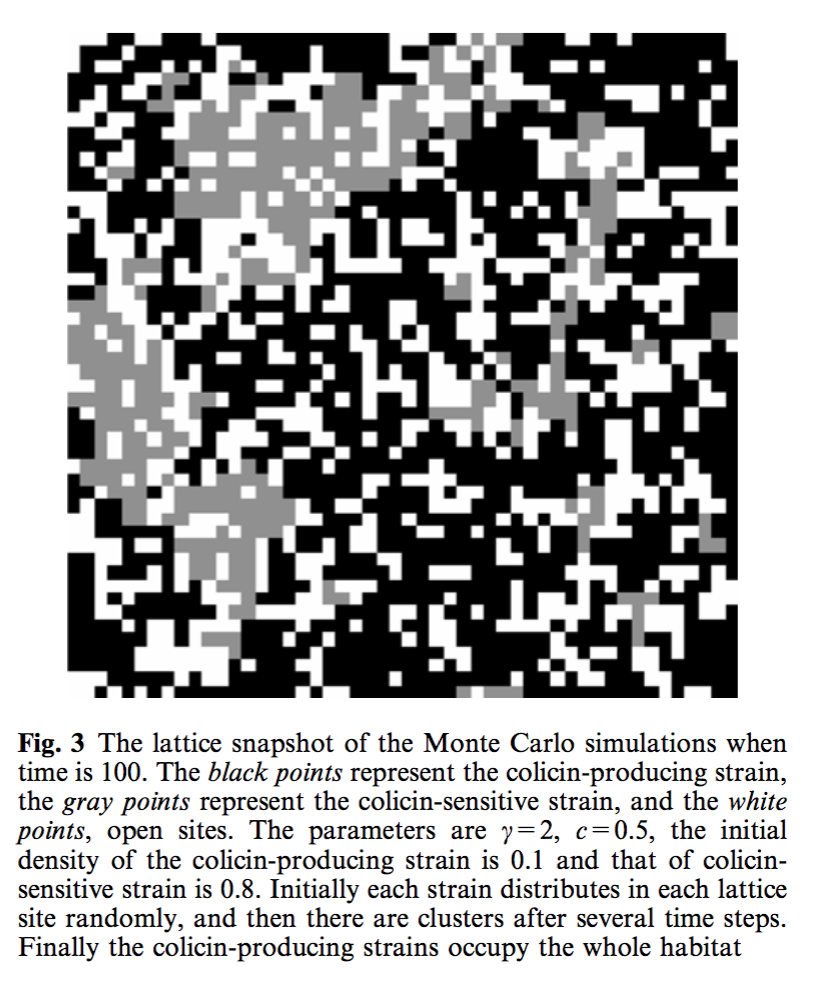Lattice Models in Ecology and Social Sciences
Nakamaru, Mayuko. “Lattice Models in Ecology and Social Sciences.” Ecological Research 21, no. 3 (May 1, 2006): 364–69. doi:10.1007/s11284-006-0163-0.
Nakamaru (2006) explored the influence of different spatial structuring on the evolution of behavior in ecological and social systems. The focal spatial structures were the complete-mixing and lattice models. A complete-mixing, or mean-field model, assumes that an individual can randomly interact with any another individual with equal chance, as in a homogenous mixture. A lattice model distributes individuals across a landscape and limits the interactions to those between neighbors, although the exact “size” of the neighborhood is flexible. Nakamaru then uses these relatively simple spatial structures to illustrate how they can promote the evolution of different behavioral strategies in three examples.
Spiteful behavior is when an individual reduces other individuals’ fitness at a cost to oneself. Using empirical and simulation studies, Nakamaru shows that in a completely mixed structure, spiteful strains cannot invade because of the higher costs incurred by their spite. However, in a lattice model, a spiteful strain can invade because interstrain competition is limited to the boundary of the invasion wave. In this scenario, the populations, although beginning at a random dispersion, become clustered after several timesteps.
Nakamaru then used a game model to explore the difference in the evolution of cooperation and punishment in different spatially structure populations. It is theorized that cooperation and punishment have co-evolved, with punishment serving as the driver of non-kin cooperation. In this case, cooperators who punish self, non-cooperators gain benefits from cooperation, which overrides any costs due to their role in punishment. These punishing cooperators are known as Altruist-Punishers (APs). This is a similar situation to spite, and resulted in the same conclusions regarding well-mixed and lattice models. However, Nakamaru added complexity by adjusting how individuals in the game die and colonize a site. In the score-dependent fertility mode, individuals die randomly and colonize according to their fitness “score”. The score-dependent viability model allows individuals to die according their score, and then randomly colonize open sites. The score-dependent fertility model was the same as the spiteful results above. However in the score-dependent viability model, the AP population can invade in both the well-mixed and lattice scenarios, however they are able to do so from lower numbers in the lattice scenario.
This struck me a similar to trade-offs amongst a genetically, or phenotypically, diverse population. If the population is well-mixed, the end composition of traits will be dependent on the initial proportion, eventually leading to a genetically homogeneous population, dependent on initial conditions. The lattice model allows both to persist because any individuals “inside” the cluster are only interacting with those with a similar trade-off, and therefore experience reduced competition and are able to persist.
These studies modeled the movement of individuals, and used the landscape-scale patterns to infer what this means for evolution. It illustrates how individual-scale interactions can lead to much larger-scale patterns, however these simplified models focus solely on the interaction between two strains or populations, as noted by the author, and do not allow for stochastic dynamics or mutations amongst the population. Further work that expanded this to models with more than two types of individuals may have unpredicted results and should be pursued to understand the evolution of these behaviors in more realistic systems.
 Clustering of spiteful behavior in a lattice model. Note that the distribution was originally random.
Clustering of spiteful behavior in a lattice model. Note that the distribution was originally random.
